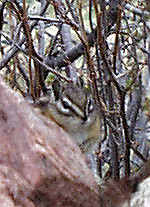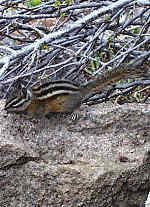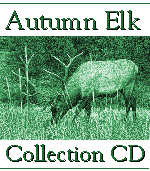
 |
Tips
for Observing & Photographing Chipmunks in the Wild
- Always
make slow movements when observing wildlife.
- Most
chipmunks will flee if you approach closer than 10 or 15 feet
of them. However, if you remain still they may come very close
to you as they are very curious little critters. Use of a
telephoto lens can help you capture a memorable picture while
causing the animals little or no stress.
- Avoid
using a flash when photographing wildlife. A camera flash
can startle them as well as momentarily blind them from dangers
in their area.
- Avoid
making loud noises. Any noise above a whisper will be noticed
as a possible threat by wildlife.
- Do
Not Feed Wildlife. This is illegal in most states and
is not healthy for the animals.
- Use
Caution when observing any wild rodents. Rodents often carry
fleas and in many areas of the Southwest and Western, North
America, those fleas can carry deadly or dangerous diseases.
Although I know of no cases regarding chipmunks, it is always
wise to be cautious.
Remember...
being kind to wildlife has many mutual benefits... Enjoy the
beauty which nature has provided for us to enjoy... While trying
to make the least impact with your presence as possible... Your
efforts will be rewarding...
|

Chipmunk Gallery
Chipmunks
Main Page

|